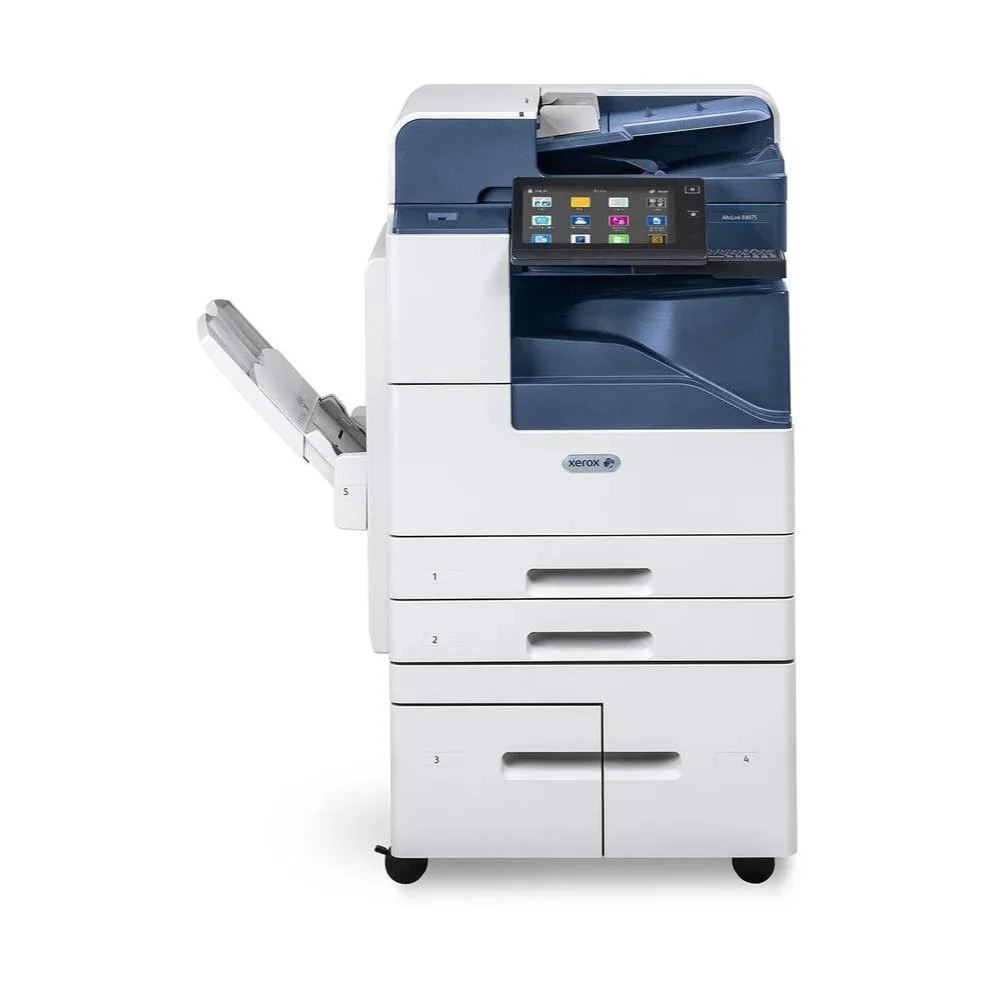
Universal Print
Universal Print is a cloud-based print protocol that provides a simple and secure print solution for Microsoft® 365 users. Universal Print allows administrators to manage printers without the need for on-premises print servers. Universal Print enables users to access cloud printers without the need for print drivers.
You can use the Universal Print page to enable and register your Xerox® device for Universal Print.
• When Universal Print is enabled, the configuration settings appear. The Universal Print area displays the registration status of your device.
• When Universal Print is disabled, the configuration settings are hidden. The Universal Print area shows the status Off. This status is the default.
UNIVERSAL PRINT STATUS
The Universal Print area displays the registration status of your device for Universal Print. The statuses include the following:
• Not Registered: This status appears when Universal Print is enabled but the device is not registered.
• Pending Registration: This status appears when registration is in process.
• Registered: This status appears when Universal Print is enabled and the device is registered.
• Registration Expired: This status appears when the Universal Print registration certificate expires.
REGISTERING A DEVICE FOR UNIVERSAL PRINT
Before you register a device for Universal Print, ensure that TLS 1.2 is configured. For details, refer to TLS.
Note: If your organization uses a proxy server, ensure that the proxy server settings are configured for Universal Print. For details, refer to Proxy Server.
1. In the Embedded Web Server, click Properties > Connectivity > Setup.
2. For Print and Scan Workflows, for Universal Print, click Edit.
3. In the Configuration area, to enable Universal Print, click the toggle button.
4. To set the Job Check Frequency, click in the row. The Job Check Frequency page appears. Select 30 Seconds, 2 Minutes, or 4 Minutes, then click Save.
The job check frequency sets the interval that the device uses to poll the Universal Print service for available print jobs.
5. To update the device name, click in the Device Name row. The Description page appears. Update the device name, then click Save.
6. To change the TLS setting, click in the row. The TLS page appears. Ensure that TLS 1.2 is configured, then click Save.
Note: If Universal Print is enabled, and you attempt to change the TLS version to TLS 1.3 only, an alert appears. To function correctly, Universal Print requires TLS version 1.2.
7. Click Register. The registration process authenticates the device with Microsoft Entra ID. Microsoft Entra ID formerly known as Azure® AD.
Note: Microsoft Entra ID is the new name for Azure AD. The names Azure® Active Directory, Azure AD, and AAD are replaced with Microsoft Entra ID.
a. If authentication fails during the registration process, a message window appears. Respond as needed.
• Cannot Connect: If this message shows, verify the network connection, then attempt registration again. To investigate further, view the authentication log.
• Registration Attempt Failed: If this message shows, click View Authentication Log. For details, refer to Authentication Log.
• Duplicate Registration: If this message shows, registration for the device is already in progress.
b. If authentication is successful during the registration process, the Register Device window appears. To copy the registration code, click Copy, then click Register Device with Microsoft.
Note:
• When registration is in process, you cannot cancel the action.
• The registration process needs to complete before the code expires.
• The registration code expires after 15 minutes.
8. A new Web browser window opens. Do the following:
a. At the Enter code window, paste the registration code into the Code field, then click Next.
b. At the Pick an account window, select the appropriate Microsoft® account.
Note: For registration, select an available Microsoft® account. The selected account is used solely to establish a trusted connection for the device with the Universal Print service. After registration, Universal Print does not use the account again.
c. A Xerox Discovery Universal Print Connector window appears. Close the window.
9. To complete registration, at the Universal Print window, click Verify Registration Status. Continue to click Verify Registration Status until the status changes to Registered.
Note: If verification is in progress, a Verification Still Pending window appears. Close the window.
10. If the code expires or registration fails, a status of Not Registered appears in the Universal Print area. Repeat the registration process.
11. If registration is successful, a status of Registered appears in the Universal Print area. The device is available as a cloud printer in the Universal Print service.
12. To allow users to access the device, the Azure® administrator needs to share the printer in the Microsoft Entra ID portal. Microsoft Entra ID formerly known as Azure® AD.
a. In a Web browser, go to https://portal.azure.com/#home.
b. For Azure services, click Universal Print.
c. In the Manage area, click Printers.
The list of registered printers appears.
d. Select your printer, then click Share Printer.
The Share printers window appears.
e. To change the default printer name, update the Share name field for the cloud printer. A unique share name allows the users to easily identify the cloud printer in the network.
f. To allow access to the cloud printer for everyone in the organization, click the toggle button.
g. To select the users that you need to share the printer with, in the Select member(s) area, click the names of the users. To locate users, use the search by name option.
h. Click Share Printer. When printer sharing is complete, a confirmation message appears.
After the printer is shared, an authorized user can discover the device using the Add Printer feature in Windows 10. The device appears as a cloud printer in the discovered printers list.
To add a cloud printer in Windows 10, click Settings > Printers & Scanners > Add a printer or scanner. Select the cloud printer in the list of discovered printers, then click Add device.
ADMINISTRATOR FUNCTIONS FOR UNIVERSAL PRINT
When a print job is submitted to Universal Print, it is queued in the cloud until the printer fetches the job. The printer checks for jobs after the polling interval elapses, or when you initiate the Check For Jobs Now function.
The following functions are available:
• Check For Jobs Now: Use this function to check the cloud for pending print jobs. Available jobs are transferred to the device active jobs queue.
Note: If a connection failed message appears, verify the network connection, then check for jobs again. If the error persists, refer to the authentication log.
• Test Connection: Use this function to test connectivity to the cloud. If the test fails, to investigate further, view the authentication log.
• Deregister: Use this function to deregister the device from the Universal Print service. Deregistration requires a deregistration code and follows a similar process to registration.
• Active Jobs: Use this function to view jobs in the device active jobs queue. Active print jobs include jobs that are in the queue and jobs that are printing. The active jobs queue does not show completed jobs.
Note: At the device control panel, in the Jobs App, Universal Print jobs are signified by a cloud print icon.
Note: Microsoft Entra ID is the new name for Azure AD. The names Azure® Active Directory, Azure AD, and AAD are replaced with Microsoft Entra ID.
Universal Print Secure Release
For Universal Print Secure Release, the Entra ID or Azure® administrator needs to choose a new setting and change the type of the Universal Print queue to Secure Release. At the printer, Secure Release from Universal Print can be performed when the Login Method is set to Identity Provider (IdP) or Smart Cards. For more information, refer to Xerox® AltaLink® Series Identity Provider Configuration Guide in Product Support and Drivers – Xerox.
SETTING UP UNIVERSAL PRINT ON MACOS
Universal Print is supported in macOS Ventura 13.3 or later versions. Before you can find and use Universal Print printers from macOS, ensure that you have an active Microsoft Entra ID account and at least one Universal Print eligible license.
Note: Microsoft Entra ID is the new name for Azure AD. The names Azure® Active Directory, Azure AD, and AAD are replaced with Microsoft Entra ID.
1. Install the Universal Print app from the Mac App Store.
2. To open installed applications, click the Apple logo, then click System Settings.
3. Navigate to Universal Print in the left navigation menu. Sign in using your Microsoft Entra ID account credentials.
4. Click Add Printer. Select your printer from the list of available printers. You can also search for a specific printer by name or location.
5. Select your printer, then click Add. The printer is now available to use from any application on the device.
Note: Installed printers are displayed in the system print dialog for all users on the device. If you do not have permission to use a printer, your print job fails.
6. From any application that supports printing, click Print or press CMD+P to open the system print dialog.
7. Select your printer that is registered with Universal Print.
Set the printing attributes, such as number of copies and pages, then click Print.

